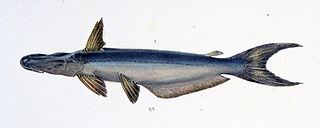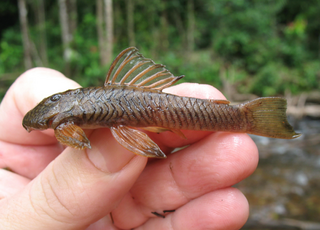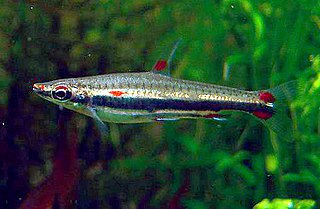 W
WAgeneiosus ucayalensis is a species of driftwood catfish of the family Auchenipteridae. It can be found in South America.
 W
WAnableps anableps, the largescale four-eyed fish is a species of four-eyed fish found in fresh and brackish waters of northern South America and Trinidad. This species grows to a length of 32 centimetres (13 in) TL. This fish can be found in the aquarium trade. The fish does not actually have four eyes, but instead each eye is split into two lobes by a horizontal band of tissue, with each lobe having its own pupil and separate vision. This allows the fish to see under and above the surface of the water at the same time.
 W
WBoulengerella cuiveri, commonly known as the bicuda, is a species of pike-characin in the family Ctenoluciidae.
 W
WThe slender catshark is a small species of catshark belonging to the family Scyliorhinidae. It is found on the upper continental slope off the coast of Suriname, French Guiana and northern Brazil, including the mouth of the Amazon River at depths between 72 to 450 metres. Its it can grow up to a length of 70 centimetres (28 in).
 W
WThe Cetopsidae are a small family of catfishes, commonly called the whale catfishes.
 W
WCopella arnoldi, commonly known as the splash tetra or the splashing tetra, is a species of tropical freshwater fish belonging to the family Lebiasinidae. It is native to South America.
 W
WThe gilded catfish or jau is a South American catfish of the family Pimelodidae. Also known as manguruyu or black manguruyu.
 W
WGoeldiella eques is a species of three-barbeled catfish that occurs in the Guianas and the Amazon basin of Brazil, Peru and Venezuela. This fish reaches a length of 28.9 centimetres (11.4 in) SL. It is the only species of its genus.
 W
WGuyanancistrus nassauensis is a species of catfish belonging to the family Loricariidae, the suckermouth armored catfishes. It is discovered in 2005 and formally described in 2018. G. nassauensis is a rare species, highly endemic to the Nassau Mountains in Suriname, and is threatened with extinction by proposed or ongoing mining activities.
 W
WHypostomus plecostomus, also known as the suckermouth catfish or the common pleco, is a tropical fish belonging to the armored catfish family (Loricariidae), named for the armor-like longitudinal rows of scutes that cover the upper parts of the head and body. Although the name Hypostomus plecostomus is often used to refer to common plecostomus sold in aquarium shops, most are actually members of other genera.
 W
WThe keyhole cichlid is a cichlid fish endemic to tropical South America, occurring in the lower Orinoco Basin in Venezuela and river basins in The Guianas. It is the only species in the genus Cleithracara. The species is popular with fishkeeping hobbyists and is frequently kept in aquariums.
 W
WNannostomus,, is a genus of fish belonging to the characin family Lebiasinidae. All of the species in this genus are known as pencil fish or pencilfish, a popular name that was first only applied to two species in the 1920s, Nannostomus unifasciatus and Nannostomus eques, but by the late 1950s would come to be applied to all members of the genus. Several of the species have become popular aquarium fish due to their attractive coloration, unique shape, and interesting demeanor.
 W
WThe porthole shovelnose catfish or spotted shovelnose catfish, Hemisorubim platyrhynchos, is the only species in the genus Hemisorubim of the catfish family Pimelodidae.
 W
WPotamotrygon orbignyi, or the smooth back river stingray, is a species of river stingray in the family Potamotrygonidae. It is found in the Amazon and Orinoco River basins in South America.
 W
WPseudacanthicus is a genus of medium to large-sized suckermouth armored catfishes native to South America, where found in the Amazon and Orinoco basins, as well as rivers of the Guianas. They are primarily found in fast-flowing waters, sometimes relatively deep. They are sometimes kept in aquariums.
 W
WPseudacanthicus fordii is a species of armored catfish endemic to Suriname where it occurs in the coastal river drainages. This species grows to a length of 23 centimetres (9.1 in) TL.
 W
WPseudoplatystoma fasciatum or barred sorubim or barred catfish is a species of long-whiskered catfish native to the Suriname, Corantijn and Essequibo. The nocturnal predator feeds mainly on other fish and crabs. Females reach a more notable size. They become sexually mature at 56 cm (22 in), males at 45 cm (18 in) and this species reaches a maximum length of 90 cm (35 in) TL. Fecundity seems to be estimated at 8 million eggs per kg, but was recently measured in aquaculture at a lower, and more likely number of 150,000 eggs laid per kg.
 W
WThe daggernose shark is a little-known species of requiem shark, in the family Carcharhinidae, and the only extant member of its genus. It inhabits shallow tropical waters off northeastern South America, from Trinidad to northern Brazil, favoring muddy habitats such as mangroves, estuaries, and river mouths, though it is intolerant of fresh water. A relatively small shark typically reaching 1.5 m (4.9 ft) in length, the daggernose shark is unmistakable for its elongated, flattened, and pointed snout, tiny eyes, and large paddle-shaped pectoral fins.
 W
WThe sharpsnout stingray or wingfin stingray is a species of stingray in the family Dasyatidae, found from off Venezuela to northern Brazil. It inhabits shallow, brackish water, shifting towards the coast in the dry season and away from it in the rainy season. Typically measuring 70 cm (28 in) across, this dark brown ray is easily identifiable by its long, projecting snout and elongated, acutely pointed pelvic fins. Its diet consists of bottom-dwelling invertebrates. Reproduction is aplacental viviparous, with females bearing one to three pups annually. Naturally uncommon and slow-reproducing, the sharpnose stingray is under pressure by both artisanal and commercial fisheries, leading the International Union for Conservation of Nature (IUCN) to assess it as Near Threatened.